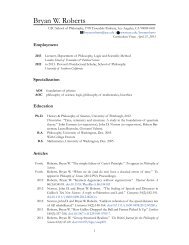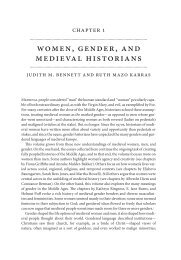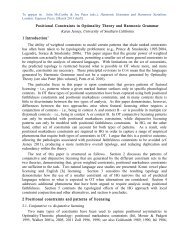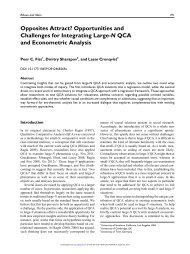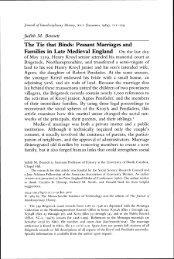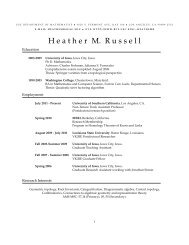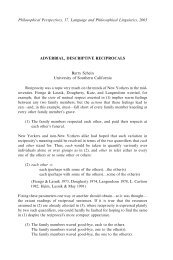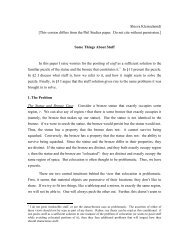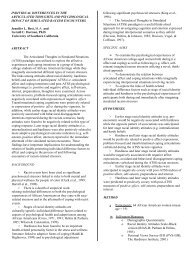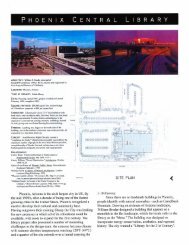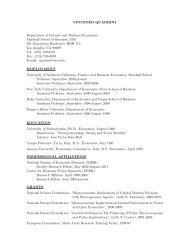The Racial Resegregation of Los Angeles County, 1940-2000
The Racial Resegregation of Los Angeles County, 1940-2000
The Racial Resegregation of Los Angeles County, 1940-2000
Create successful ePaper yourself
Turn your PDF publications into a flip-book with our unique Google optimized e-Paper software.
shrinking size and location vis-à-vis the “new immigrants.” Latinos and Asians, by<br />
contrast, are dynamic populations, growing spatially, numerically, and proportionally.<br />
<strong>The</strong>ir communities are exploding around many nodes <strong>of</strong> original settlement. <strong>The</strong>ir<br />
increasing isolation is a function <strong>of</strong> the classic “immigrant enclave” effect. As our use <strong>of</strong><br />
the “exposure index” makes clear, Whites and Blacks together have been somewhat more<br />
likely to have Latino and Asian neighbors (simply because they are outnumbered), but<br />
Latinos and Asians are decreasingly likely to have White or Black neighbors.<br />
While we find these patterns to be very clear, we also want to emphasize that they are not<br />
the whole story. This study treats <strong>Los</strong> <strong>Angeles</strong> <strong>County</strong>, the nation’s most populous at 9.5<br />
million persons) as a single continuous space. Two companion Public Research Reports<br />
from our study group analyze the wide variance <strong>of</strong> conditions among the many specific<br />
places within LA <strong>County</strong>. 1<br />
It is also too early draw a complete set <strong>of</strong> conclusions about many <strong>of</strong> the possible causes<br />
or effects <strong>of</strong> these findings. “Segregation” is used here as a descriptive term, rather than<br />
as a normative one. It has had, and certainly can have reprehensible causes and socially<br />
destructive effects. It can still be, can certainly has been, caused by overt or systematic<br />
housing or job discrimination. When linked to locational disadvantages such as high<br />
crime rates, low job opportunity, and poor schools, it can have very negative effects. We<br />
have other research projects 2 under way to identify these causes and effects, but this<br />
paper sets out primarily to establish the patterns themselves.<br />
Even within the descriptive boundaries <strong>of</strong> this analysis we have been able to identify two<br />
“causes” that have operated to produced the resegregation <strong>of</strong> <strong>Los</strong> <strong>Angeles</strong> <strong>County</strong>:<br />
a) <strong>The</strong> simple spatial arithmetic <strong>of</strong> population dynamics. <strong>The</strong> explosion <strong>of</strong> Latino<br />
and Asian immigrant populations and steady shrinkage <strong>of</strong> White and Black<br />
populations “explains,” in a statistical sense, the moderate increase in White<br />
exposure to people <strong>of</strong> color and the rising levels <strong>of</strong> isolation among the new<br />
immigrants.<br />
b) <strong>The</strong> patterns <strong>of</strong> White residential behavior. Alone among the four principle racial<br />
groups, we can say with confidence that Whites have had the freedom to settle<br />
wherever their wealth enables them to purchase a home. <strong>The</strong>y have used that<br />
freedom to flee the growing diversity <strong>of</strong> the metropolis, either by moving out <strong>of</strong><br />
the county completely or by retreating to its edges. 3<br />
1 Myers and Park (Race Contours <strong>2000</strong> Public Research Report 2001-05) emphasize the growth <strong>of</strong><br />
“<strong>Racial</strong>ly Balanced” cities since 1980 among the 177 cities <strong>of</strong> <strong>Los</strong> <strong>Angeles</strong> <strong>County</strong>, Orange, Riverside, San<br />
Bernardino, and Ventura counties. Frey and Ethington (Race Contours Public Research Report 2001-06)<br />
emphasize the variance in segregation indices among 77 cities <strong>of</strong> <strong>Los</strong> <strong>Angeles</strong> <strong>County</strong> from 1990 to <strong>2000</strong>.<br />
2 Ethington, “Segregated Diversity” (Haynes Foundation Final Report, August <strong>2000</strong>) shows a very<br />
strong correlation between White residential location and high median home prices, suggesting that the<br />
“cause” <strong>of</strong> White/nonwhite segregation is a barrier <strong>of</strong> very high property values that prevents Blacks and<br />
new immigrants (all upwardly mobile groups) from entering White neighborhoods.<br />
3 To some extent, members <strong>of</strong> each racial group have freedom to settle where their wealth can<br />
afford a home, and a crucial effort in our ongoing research is to better understand the voluntary decisions <strong>of</strong><br />
Race Contours <strong>2000</strong> –<strong>Resegregation</strong> <strong>of</strong> <strong>Los</strong> <strong>Angeles</strong> <strong>County</strong>, <strong>1940</strong>-<strong>2000</strong> 2



